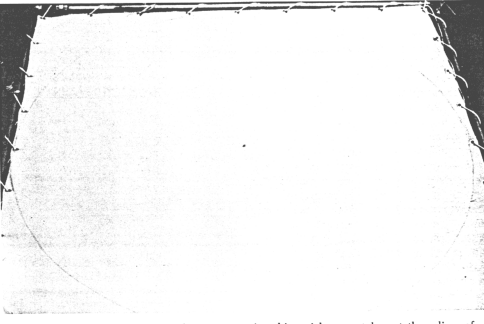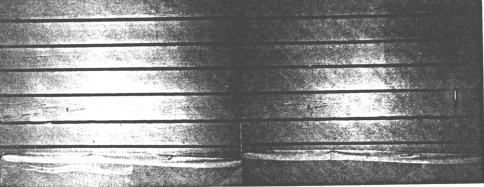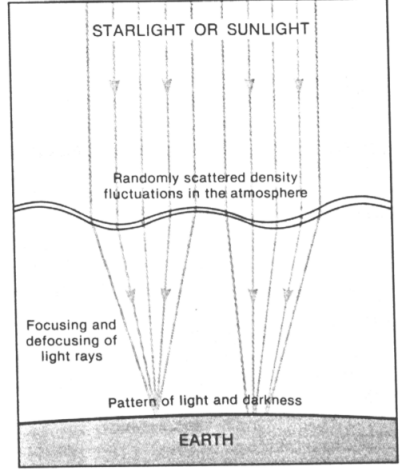Shadow Bands - Solar Eclipse Phantoms
LAURENCE A. MARSCHALL, Gettysburg College, Pennsylvania
The author received his Ph.D. in astronomy and astrophysics from the University of Chicago. His research interests are atmospheric optics and astrometric studies of star clusters.
(From Sky & Telescope, February 1984, pages 116/118)
SHADOW BANDS, or "flying shadows" as they are sometimes called, are among the most ephemeral of natural phenomena. During the few minutes just before or after the total phase of a solar eclipse, the ground may suddenly become alive with faint moving patterns of light and darkness, like ripples of sunshine at the bottom of a breeze-stirred swimming pool. The effect may be uncanny, and even a veteran observer may be startled, since the vividness and rapidity of the display vary unpredictably from one eclipse to the next.
Shadow bands are no doubt produced by a combination of astronomical and atmospheric causes. The astronomical circumstances can be calculated with great precision: The crescent of uneclipsed Sun must appear very thin in the sky, approximately 15 arc seconds across at the center. On the other hand, the atmospheric causes -- the turbulent fluctuations of density and pressure that also produce stellar "seeing" -- are much more complex, and their effects less well understood. Nevertheless, any total or nearly total solar eclipse offers a chance to view this rare natural occurrence. With luck, thousands of observers at the nearly total annular eclipse of May 30, 1984, will catch sight of the fleeting patterns. (Earlier articles on this subject by Andrew T. Young appeared in Sky & Telescope, September, 1970, page 176; October, 1970, page 242; and May, 1972, page 291.)
Early reports of shadow bands are hard to come by, as is true for most eclipse-related phenomena. Their importance to the study of solar physics was only recognized in the middle of the 19th century. Still, they were no doubt widely observed. Reports of the elaborate expeditions to Colorado in 1878 show that, by then, observers were well prepared for the appearance of the "diffraction bands" that were duly seen and recorded. While shadow bands have been seen at many total and several partial solar eclipses since late in the last century, there have been notable "vintage" years. On January 25, 1925, bands were widely seen throughout the northeastern United States, being sharply imaged on a blanket of newly fallen snow. Another flurry of sightings was recorded at the March 7, 1970, eclipse, which was also viewed from the East Coast. Fringe visibility can vary widely from place to place, and it is also probable that the rise and fall in number of reports is due as much to the number of people on hand as to the intrinsic intensity of the display. Most shadow-band accounts are merely descriptive and often only fleeting impressions. After all, the phenomenon is merely a sideshow to the grand spectacle in the sky. Besides, as we shall see, the fringes are difficult to record photographically or photoelectrically.
WHAT TO EXPECT
Despite their name, shadow "bands" appear most often as elongated patches or mottled irregular patterns, rather than as evenly spaced stripes of darkness and light. M. Minnaert, in his classic The Nature of Light and Colour in the Open Air, likened them to "the folds of a gigantic curtain," while Samuel A. Mitchell in Eclipses of the Sun, 4th edition, reported them as "broken and confused arches or short blotches of light." Others have described "undulating zones of light and dark," rippling "like a smoky haze," disappearing, reappearing, and merging with ghostlike fluidity. There is always a sensation that the patterns are trembling, and often an impression that they are moving together in a direction perpendicular to their elongation.
Shadow bands have several fundamental characteristics:
· The patterns consist of elongated, often wavy, bands or blotches of light and shadow from half an inch to several inches in width. Intervals of light and shadow may appear equal in extent, or gaps of several feet can appear between patterns of light or shadow.
· The patterns are elongated tangent to the edge of the Moon's shadow on Earth. Therefore, near the center line of an eclipse the band orientation is the same before and after totality. Near the edges of the eclipse track the band orientation can shift as much as 90°
· While they sometimes seem stationary, bands may appear to move perpendicularly to their length at a speed of several feet per second. Individual blotches of light and shadow may appear, blend, and disappear with such rapidity that an individual pattern moves only a few feet before dissolving.
· Bands are visible for several seconds to several minutes before and after totality -- longer at partial and annular eclipses. The bands' contrast is strongest, and the spacing between patterns is least, when the uneclipsed solar crescent is smallest.
· There is some suggestion that the contrast between light and shadow is greater at shorter wavelengths. Thus the pattern should be most visible in blue light and least noticeable in red.
CAUSES
Because their linear patterns roughly resemble optical interference fringes, 19th-century observers assumed that shadow bands were some sort of diffraction phenomenon. The Sun, however, is far from the necessary point source of light, and the patterns seem more random and blotchy than simple diffraction patterns. The bands' speed is inconsistent with such a model. The i>actual diffraction pattern from the Moon's edge, as observed in stellar occultations, travels at 1 kilometer per second -- not the much slower speeds reported for the bands.
All the shadow-band photographs accompanying this article were taken at the eclipse of March 7, 1970. This one was supplied by Harper J. Whitehouse.

More exotic explanations have been proposed. In 1924 Guido Horn-D'Arturo suggested that the bands were overlapping pinhole images of the Sun formed by
spiragli or gaps in our upper atmosphere. More recently Augustus L. Stanford has proposed a "Lloyd's mirror" effect, where direct rays from the uneclipsed solar crescent interfere with those reflected from clouds.
But by far the simplest and most satisfactory explanation of shadow bands is that they arise from atmospheric turbulence. Fluctuations in density and temperature, random eddies up to several inches in size, are constantly appearing and disappearing. When light rays pass through one of these eddies, they are slightly refracted, or bent, just as if they had passed through a lens.
Light from a distant source is randomly focused or diverged by this fluctuating air turbulence. If the source's angular size is small enough, as in the case of a distant star, its rays may be affected by only a few turbulent elements, and as these fluctuate the brightness varies. From objects of larger angular extent we receive light affected by a larger number of eddies, and the variations average out. This is why the planets twinkle less than stars, and the Sun and Moon do not twinkle at all.
The accompanying diagram shows how atmospheric turbulence produces a pattern of light and shadow on the ground when illuminated by a star. Normally this pattern is too faint to be seen, but it can be viewed as a patchy illumination by pointing a telescope at a bright star and looking through it after removing the eyepiece.
Atmospheric turbulence is not confined to a single layer (like the surface of a pond) and can be distributed throughout the air. At every altitude there will be a particular element size that is most effective in focusing light. For instance, eddies that bend light severely are most effective at low altitude; at greater heights they produce out-of-focus patterns that overlap and illuminate the ground uniformly. Shadows produced by this random distribution of turbulence reveal only "average" patterns of the refractive atmosphere above.
Minnaert saw shadow bands cast by Venus on the wall of a darkened room, but the Sun is ordinarily too large in angular size to produce sharp patterns -- too large except at a solar eclipse, that is! When the angular width of the solar crescent is comparable to that of a typical eddy (a few arc seconds), the turbulent patterns of our atmosphere should spring into sharp relief. Since the uneclipsed crescent is much wider in the direction tangent to the Moon's shadow, the pattern should be spread out more diffusely in that direction. This neatly explains the observed orientation of the bands.
These very faint diagonal shadow bands on the side of a house were recorded by Rev. Stanley E. Hastillo just before totality. His '/250-second exposures on Tri-X film were printed on very contrasty Agfa No. 6 paper.

The pattern's motion may be influenced in part by local winds. However, the bands appear to move only perpendicular to their elongation, since the Sun's image is sharply focused only in this direction. The changes in the bands' width and contrast simply follow the changes in the uneclipsed Sun. When the crescent is narrowest, turbulence is most effective in producing sharply focused images of the slender Sun. This narrowing also may heighten the sense of band motion.
The bands' greater visibility at shorter wavelengths may be due simply to the fact that the solar limb darkening is more pronounced in the blue than in the red. Thus the solar crescent appears narrower and more sharply defined in blue light, producing more noticeable patterns at the shorter wavelengths. Air's greater refracting power at shorter wavelengths may play a minor role as well, especially for atmospheric elements that are most effective in creating the bands. But this process would not change the overall band pattern.
STARLIGHT OR SUNLIGHT
Shadow bands, like the twinkling of stars, are believed to be caused by density fluctuations scattered randomly through the Earth's atmosphere. These transient eddies bend light rays from a celestial source, sometimes focusing them, and sometimes spreading them over the ground below.

PHOTOGRAPHING THE BANDS
Capturing shadow bands on film is not a straightforward matter and remains a real challenge. Light levels near totality are low and the pattern's contrast is also low -- only about one percent. As the bands move rapidly, exposures of less than '/250 second are required to avoid smearing them out. High-speed film, careful choice of exposure time, and high-contrast printing are necessary to produce good results. Sharp, well-defined shadow bands could give interesting information on the size distribution of the turbulent eddies causing the phenomenon, but only a few relatively clear photographs have ever been published. Several of these are reproduced on this and the preceding page.
I have tried to photograph artificial bands, such as those cast by a bright light passing over a radiator. However, even in the laboratory, it is difficult to avoid a blurred or blank image. It would be helpful, well before the crucial minutes of eclipse, to take numerous practice frames of the patterns cast by a ripple tank or the rays from a small arc lamp passing over a hotplate. Even then, as it is difficult to gauge the level of illumination precisely, a lot of good luck may be needed.
PHOTOELECTRIC OBSERVATIONS
The most successful shadow-band observations to date have been photoelectric. Since 1966 a group from Ball State University has been using a variety of detectors, including photodiodes and cadmium sulfide photocells. More extensive observations and analyses were carried out by John J. Quann and Christopher J. Daly at the March, 1970, eclipse. They investigated the frequency distribution of the bands in addition to the wavelength dependence noted previously. Most shadow-band fluctuations occur at low frequencies, about 1 to 20 hertz (cycles per second), with the intensity falling off steeply from 50 to 60 Hz. This behavior is similar to that of stellar scintillation seen through a small-aperture telescope and suggests that the two phenomena are the same.
Four photoelectric detectors, spaced 2,0 centimeters apart, produced tbese outputs during the February M, 1980, eclipse. Shadow bands are the small fluctuations superimposed on the generally decreasing solar illumination. Shown is an 8-second interval beginning about RO seconds before totality. Illustration by the author.

| Some Eyewitness Accounts |
|
From the report of C. L. Brook on the eclipse of May, 28, 1900:
|
| The word "bands" is not at all applicable to what we saw; we spent at least four minutes after totality in critically examining the structure of the shadows, and we came to the conclusion that there was no real linear arrangement, much less single bands of definite breadth stretching across the sheet; ripples raised in water by a slight breeze represent best what may be termed the structure of the shadows; they all move in the same direction, each ripple element is linear in character but retains its own individuality only for a moment, appears to dissolve away, and others take its place. |
|
Sebastian Albrecht reported that on January 25, 1925:
|
| They would appear, tremble for one or two or three seconds (or as my daughter remarked, "shiver in the cold") and then run at right angles to their length. At times they would fade out and immediately be replaced by new ones. |
|
Also in 1925, Rebecca Joslin noted:
|
| This valuable scientific research was suddenly brought to a close by the arrival from Venus of fairies, waving their gossamer scarfs (prosaically called "shadow bands") and dancing so fast, oh so fast and airily, that we were bewildered in our attempt to chase them. Their scarfs flickered and shimmered and fluttered at right angles to and away from the sun, now in the air, now in the snow. But as for breadth, texture, and number, one might as well have tried to count the flutters on the wing of a hummingbird in flight. |
At the 1980 Indian eclipse, Richard Henry, Rita Mahon, and I used an array of four ultrasensitive silicon diodes, spaced about 20 centimeters apart, to investigate the distribution of the bands in frequency and space. Our preliminary results confirm the analysis by Quann and Daly. As can be seen in the illustration at the top of this page, even the bands themselves are difficult to pick out; detailed analysis, however, shows that the correlation of fluctuations between the detectors is small. This suggests that the shadow pattetns do not persist for more than about '/5 second, disappearing before they move from one detector to the next.
A silicon photodiode can easily convert shadow-band fluctuations into an AC signal. This signal can then be transferred directly to tape, although only variations with a frequency greater than about 50 Hz will be picked up by a standard audio recorder. E. J. Seykora of East Carolina University has used this method; his instrument is sensitive enough to detect variations in illumination caused by insects flying across the field of view, and it has picked up the bands at several recent eclipses.
Unfortunately, as mentioned above, the low-frequency intensity fluctuations that comprise most of the shadow-band variations cannot be recorded easily by an ordinary tape recorder. However, it is a relatively simple task to convert the output voltage of a photodiode into an audio signal that can then be recorded satisfactorily by even a small portable cassette model. Plans for such devices can be found in
Photoelectric Photometry of Variable Stars by Douglas S. Hall and Russe11 M. Genet, and
Astronomical Photometry by Arne A. Henden and Ronald H. Kaitchuck.
Radio Shack sells an integrated-circuit "voltage-to-frequency" chip which does the job neatly. The manufacturer's instructions show how to connect the device for low-frequency tape recording, and also how to use it as a "frequency-to-voltage" converter to play back the results. I used a device of this sort, as well as one of Seykora's detectors, to record the illumination at the 1981 Siberian eclipse. Ernie Piini, a California amateur, brought along a self- contained detector-converter designed by a friend and also recorded the light variations successfully. Unfortunately, diffuse clouds washed out the shadow-bands.
The detection of shadow bands is clearly a challenging and fascinating problem. While the patterns themselves hardly represent one of the most pressing problems of modern science, details of the phenomenon still deserve study. Computer modeling of shadow bands remains to be done, in particular to clarify the role of variables that affect the patterns' visibility. What, for example, are the effects of irregularities on the Moon's limb, the darkening of the solar limb, and the distribution of turbulence in our atmosphere? Is this turbulence just the normal one that produces scintillation or, as has been suggested, is it stirred up by the passage of the Moon's shadow? How long do the individual patterns of light and shadow persist?
High-quality photographs and well-synchronized photoelectric records made by detectors spaced a few centimeters to a few meters apart can provide the most useful data to answer these questions. I would appreciate hearing from amateurs who have made or who are interested in making such observations. There is also an extensive bibliography on the subject, as well as information on photoelectric observations, which I will be glad to share with anyone requesting them. Write to me at the Dept. of Physics, Masters Hall, Gettysburg College, Gettysburg, Pa. 17325.
Even if you come to an eclipse merely to look, however, the shadow-band phenomenon is a marvelous bit of nature that shouldn't escape your notice. Surely the events in the sky at such a time are among the most gorgeous and awesome of heaven's spectacles. But, next time you view a total or nearly total eclipse, take a moment or two to watch a delicate sideshow on the Earth -- the fleeting dance of the shadow bands.




